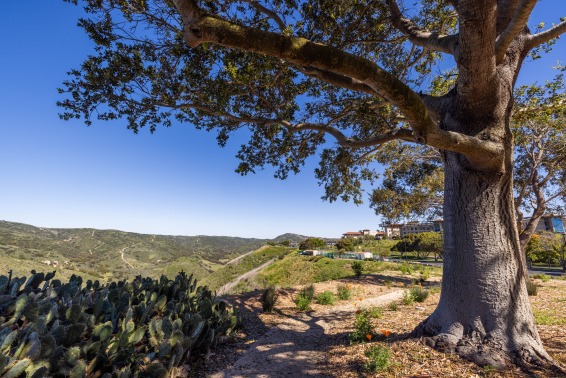Walkingstick-Romero Elders Garden
Welcome to the Walkingstick-Romero Elders Garden at Soka University of America. The garden features over 20 California native species, including the resilient Muhlenbergia rigens (deergrass), vibrant Eschscholzia californica (California poppies), and sacred Salvia apiana (white sage).
The Walkingstick-Romero Elders Garden provides a crucial space for cultivating native plants essential to traditional Acjachemen basket weaving, helping to preserve and revitalize this significant cultural practice. Visitors are welcome, but no dogs or other pets are allowed in this area, and harvesting or removal of plant materials is prohibited, except for ceremonial or traditional purposes overseen by the Acjachemen people.
Significance of the Garden
Traditionally, members of the Acjachemen community harvest native plant species for consumption, medicinal use, and cultural activities such as basket weaving and making musical instruments. Harvesting plants in nature has become exceedingly difficult for elder members who often have to walk through overgrown plants and uneven soil. The Walkingstick-Romero Elders Garden at Soka University of America was created to help address this issue. By making plant species more accessible for harvesting, Acjachemen elders can continue preserving their cultural practices and pass them on to the next generation.
Reviving Traditions
In the mid 1970s, at the Harrison House on Ortega Highway, in San Juan Capistrano, Marian Walkingstick and Teeter Romero began reviving the tradition of Acjachemen basket weaving. They had been meeting to revive cultural traditions that had been lost due to the colonization processes affecting their tribal area in Orange County. Both women knew they were Acjachemen and were determined to continue learning. As artists, the transition into basket weaving came naturally. They were self-taught, simply deciding, “This is what we want to do, so let’s go do it.” Over the years Marian and Teeter have traveled across the state, collaborating with organizations like the California Indian Basketweavers Association to revive traditional basket weaving, protect gathering areas, and advocate for the protection of weavers from pesticide contamination in these areas.
Marian Walkingstick
Marian Walkingstick is a tribal elder and esteemed basket weaver from the Juaneno Band of Mission Indians, Acjachemen Nation. She descends from the Ricardes/Dios family and hails from the villages of Alauna, Totpam, and Guaromo. As the former chairperson of the Acjachemen Nation’s Basket Weaving Committee, Marian is a well-known figure in the world of basket weaving, having appeared in numerous articles about her craft and even traveled to Africa to share her skills.
Marian spearheaded the research on Acjachemen basket weaving and played an important role in bringing people together to learn and revive the tradition. She mastered and taught two primary techniques: coiling and twining. She overcame many challenges while reviving these traditions.“The gathering is the biggest challenge,” she explained, “to make sure we are working within the law, but our forestry has been very lenient with us, very giving. It’s finding the materials and processing them. It was all around us, but identifying it and getting the proper legality taken care of so we could go on the land.” She collaborated with the Cleveland National Forest to establish a memorandum of understanding that protected traditional basket gathering areas and ensured access for Acjachemen weavers.
Together with fellow weaver Teeter Romero, Marian introduced basket weaving to local schools and to Mission San Juan Capistrano. She emphasized the importance of elders passing down the tradition to younger generations, saying, “You have to pass down that tradition, and that is what we have done.” Marian and Teeter have also educated communities about traditional and non-traditional weaving materials, highlighting the limited availability of traditional materials.
Teeter Romero
Teeter Romero is also a member of the Juaneño Band of Mission Indians, Acjachemen Nation, and a tribal elder and basket weaver. Like Marian, Teeter descends from the Ricardes/Dios family and comes from the villages of Alauna, Totpam, and Guaromo. She previously served on the Tribal Council.
Teeter began basket weaving in the early 1970s, recognizing its significance as a cultural link to her ancestors. She launched a weekly class at the Harrison House in San Juan Capistrano with a few tribal members, which eventually grew to around 20 weavers. Over the years, she dedicated herself to sharing her traditional skills and knowledge with anyone eager to learn.
Teeter has traveled extensively throughout California and beyond, teaching in many schools and organizations and receiving many accolades along the way. One of her most meaningful contributions includes speaking to schoolchildren and visitors at Mission San Juan Capistrano since the early 1970s, where she continues to share stories and give demonstrations on basketry. A gifted storyteller, she often discusses the challenges of gathering materials for traditional baskets.
In the 1970s, Teeter had concerns about gathering alone in remote areas like Ortega Highway in Orange County, where plants were most abundant. She had to arrange for companions and support from the U.S. Forestry Service, as well as permits to gather on ancestral land in places her ancestors had gathered for hundreds of years. Over the years, she has faced many hazards, from wildlife and development to run off and pesticides, making it difficult to gather materials.
For these reasons, Teeter deeply appreciates the creation of native plant gardens like the Walkingstick-Romero Elders Garden, which will provide current and future basket weavers with accessible materials and reduce the hardships involved, particularly for elders. Teeter and all those she has inspired extend heartfelt thanks to those who contributed to making this garden a reality.

